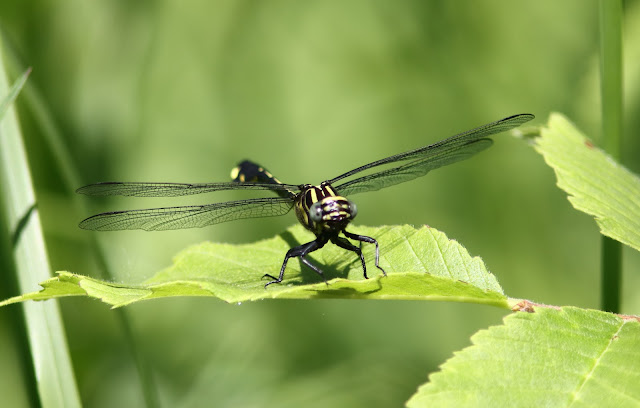Last Friday I checked out the Sombra Western Meadowlark. It finally came close and perched on the wire beside the road. Unfortunately, I was looking towards the sun, so I had to doctor the photos.
It will be interesting to see how long it stays. I doubt it will find a suitable mate!
I then went for a walk at Reid CA around the back field. More insects are showing as one would expect.
 |
| Eastern Giant Swallowtail |
 |
| Juvenal's Duskywing |
I photographed this dragonfly, not looking too close, and I did not pursue it. I should have since it was a Pronghorn Clubtail! One of the more uncommon clubtails, but regular in this area.
South of town I came across a pair of Ring-necked Pheasants. Although non-native, they are are very difficult to find in the wild anymore.
Next day, I ended up at Point Pelee. Some days I do not know what to do and just start driving! It is always a crap shoot as to what one may find. Again, I seemed to pick the wrong day. Nothing of note in birds, and hardly an odonate to be found, not to mention butterflies.
American White Pelicans area a regular feature around the Tip this time of year.
Sunday was rather rainy for the morning. In the afternoon I was bored to the point where I went for a walk at McKeough.
Azure Bluets are regular in one spot.
Turtles included a couple of Map and a couple of softshell. Of the dozens of times I have been there, I do not think I ever saw a softshell at McKeough (!).
Lots of Maps here too.
Monday was foggy to start, but very calm. I had no idea where to go, but just headed towards Rondeau. By the time I started walking, the fog had lifted. I walked the beach all the way from the light beacon, way out south beach! There was just enough activity to keep me interested.
I only saw one Little Gull this outing.
There are always things to find along the beach. I found another old shotgun shell brass. From what I can tell, it was made from 1935- early 1950's.
I really wanted to go to Wardsville this day, but the clouds and fog delayed that until after Rondeau. It was nice and sunny when I arrived at Wardsville Woods. I had high hopes for lots of odonates, but yet again, there were hardly any! However, there were some highlights.
Early on, I spotted one of the specialties for here, a Cobra Clubtail.
One of the key features is the face, where there is a line across it.
As it got warmer, more things came out including some Double-striped Bluets around the pond.
Also, a first-of-year Violet Dancer.
There were a few Twelve-spotted Skimmers.
I kept making rounds, not giving up, and later on I came across an Arrowhead Spiketail, another specialty of the property.
In fact there were two. Still looking for its cousin, the Twin-spotted Spiketail!
One can always spot a spiketail in flight. They are large and have a certain flight characteristic, at least to me. Also their perch position seems unique.
There are always lots of moths everywhere one goes, but I only look at the more attractive ones. A very common type is the White-striped Black.
Today, I just had to go to another place! Every year in June at some point I check out Joany's Woods north of Sylvan on the Middlesex border. It can be good for birds and insects. I was there a bit too early I guess, for lots of insects. There were hardly any odonates. Are we in a lull for them right now?
The only clubtail I got on was a Midland.
There were a few butterflies, including my first-of-year Great Spangled Fritillary.
For birds, the usual ones were there but not in big numbers (except Red-eyed Vireos). Blue-winged Warblers are normally plentiful there, but I only heard two in the distance over the 8+ km I walked. However, I heard five Mourning Warblers which is more than usual.
Getting to Joany's, I always pass through Hungry Hollow and by Fossil Road. Down Fossil Road one can access the river, and this is a premier spot to look for odonates. Indeed, I stopped there!
Yet again, there was hardly an ode to be seen. The river was also running very high due to the ridiculous amount of rain we have been getting lately. That is a big factor in limiting habitat.
I did see a single American Rubyspot.
I also photographed this non-descript damsel not knowing what it was. Turns out it is a female Eastern Red Damsel!
I have honestly never seen one before, but they are quite uncommon. And, rather tiny to boot. In our area, they are only seen in this spot and at nearby Rock Glen. Likely they are elsewhere in some unknown spots. Also seen in the Komoka area near London.
I did not stay long, being quite disappointed. But, going back up the slope, something caught my eye. A male Eastern Red Damsel! I was in an extremely awkward spot, so could not get proper photographs without moving and flushing it.
That certainly made my day! I will be back there later on when (hopefully) the water recedes and more odonates emerge.





























No comments:
Post a Comment